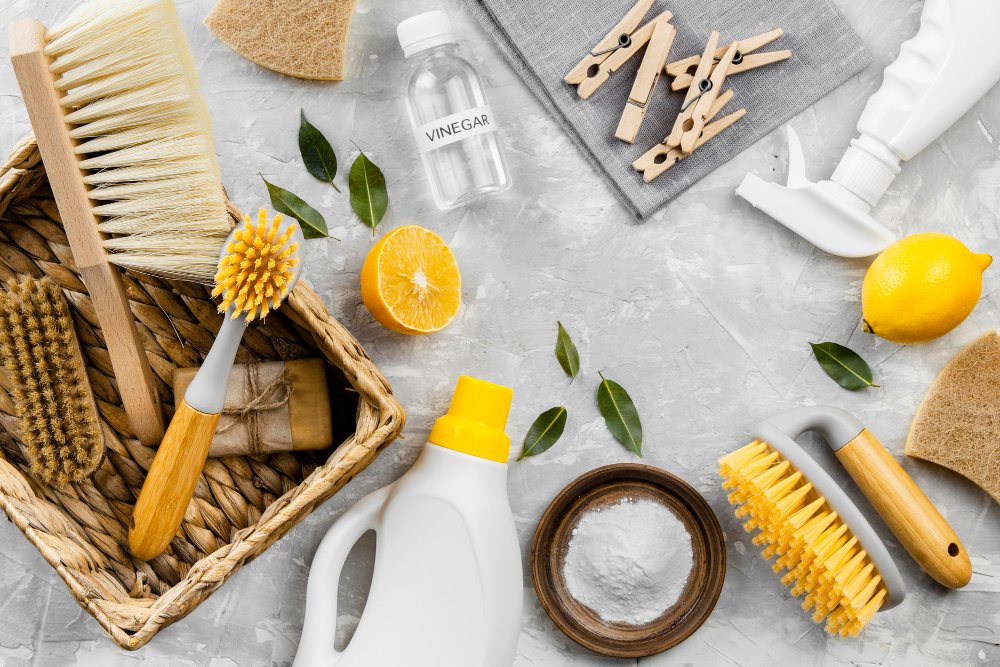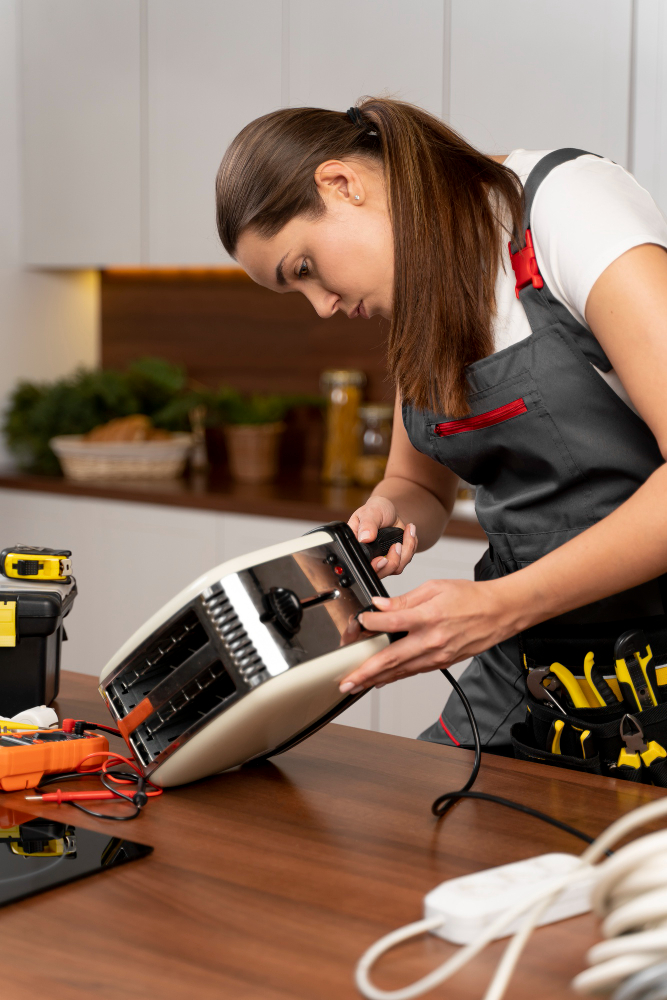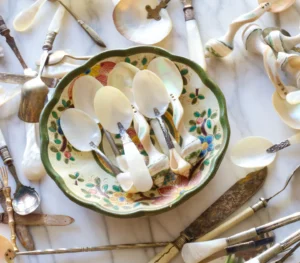Are you looking to trim your expenses? With the rise of living costs and the ever-growing need to economize, it’s no surprise that thrifty living is trending. One of the smartest ways to cut back on spending is by embracing the DIY (Do-It-Yourself) culture. Not only does this empower you to save money, but also lets you personalize your space and belongings to your taste. Here’s how you can start saving with DIY projects.
 Pin
Pin Image from Freepik.com
Table of Contents
Creative Spaces on a Dime: Mastering DIY Home Decor & Personalized Living
 Pin
Pin Image from Freepik.com
DIY home decor is a blend of creativity, resourcefulness, and practicality. It’s a way to make your living space uniquely yours without succumbing to the hefty price tags of high-end décor stores.
Here’s a more detailed look at how to bring this concept into your home:
Upcycling Thrift Finds: Scouring thrift stores, flea markets, and garage sales can unearth hidden treasures. These items often require a bit of vision and elbow grease to transform them from drab to fab. Look for sturdy pieces with good bones. An old dresser can become a chic sideboard with a fresh coat of paint and some new knobs. Old frames can be revitalized to house mirrors or new artwork. The key here is to see beyond current appearances to the potential that lies within.
Personalized Artwork: There’s something incredibly satisfying about making your own art. Whether it’s painting on a canvas, framing a beautiful piece of fabric, or creating an assemblage from found items, the options are endless. The materials can be as simple as acrylic paints, brushes, and canvases from a craft store, or as complex as a digital design blown up and printed through a local print shop. DIY art is a conversation starter and a real indication of your interests and creativity.
Handmade Pillows & Throws: Sewing may seem daunting, but it offers enormous savings and customization for home decor. With basic sewing skills, you can create pillows and throws that match your decor perfectly. Fabric stores often hold sales where beautiful fabrics can be purchased at a fraction of the cost of completed items. Even no-sew options exist, like using fabric glue or iron-on hemming tape. Choosing the fill for the pillows allows for comfort customization, and making a pillow cover means it can be removed and washed.
Reinvention and Repurposing: DIY home decor is also about reimagining the use of items. An old ladder can become a quirky bookshelf, mason jars can be turned into chic plant holders, and a stack of old books can form the base of a unique lamp. It’s about seeing things not just for what they were but for what they could become with a little modification.
DIY home decor is more than just a means to save money—it is also a process of embedding your character into your environment. Each brush stroke, each pillow pattern, and each repurposed item becomes a testament to your creativity and effort. The result is a home that is a reflection of what is important to you, outfitted in a way that is both original and economical. Not to mention the sense of accomplishment and pride that comes with being able to say, “I made that.”
Sparkling Savings and Sustainability: Mastering the Art of Homemade Cleaning Supplies
 Pin
Pin Image from Freepik.com
DIY cleaning supplies offer a compelling alternative to store-bought products, striking a balance between cost-efficiency, environmental consciousness, and health considerations.
Cost Savings:
Truly, the financial benefits of creating your own cleaning solutions can’t be overstated. Commercial cleaners often come with a hefty price tag due to marketing, packaging, and the inclusion of specialized chemicals. By contrast, homemade cleaners are crafted from inexpensive and versatile ingredients. For instance, a gallon of white vinegar often costs just a fraction of a branded cleaner but is remarkably effective in various applications. Similarly, baking soda, a common baking ingredient, doubles as a powerful cleaning agent at a minimal expense. By substituting ready-made products with homemade concoctions, you can substantially cut down your grocery expenditure.
Environmental Impact:
The ecological footprint of commercial cleaning supplies is a growing concern. These products often contain harsh chemicals that can be detrimental to the environment when rinsed down our drains, contributing to water pollution and posing risks to wildlife. Additionally, the production and disposal of plastic packaging are significant environmental issues. In creating your own solutions, you not only reduce the use of harmful substances but also minimize plastic waste through reuse of containers. Ingredients like vinegar, baking soda, and lemon are biodegradable and far less damaging to ecosystems.
Health and Safety:
Crafting your own cleaning supplies provides you with autonomy over the ingredients used, allowing you to avoid potential allergens or irritants common in off-the-shelf products. Many commercial cleaners contain synthetic fragrances and dyes that can provoke allergic reactions or exacerbate respiratory conditions. By using simple, non-toxic components, you safeguard your home environment, making it safer for children, pets, and those with heightened sensitivities.
Practical Application:
Creating a multipurpose cleaner is incredibly straightforward; commonly, it’s a cocktail of equal parts water and vinegar, with a squeeze of lemon for a fresh scent and added cleaning power. This solution can tackle windows, countertops, and even flooring. For scouring tasks, baking soda can be sprinkled onto surfaces and scrubbed to lift stubborn grime without scratching.
With these practices, the act of cleaning transforms from a chore into an act of stewardship for both your wallet and the planet. Engaging in the preparation of DIY cleaners also carries an educational aspect, instilling a mindset of resourcefulness and self-reliance.
In essence, developing a habit of crafting homemade cleaners is an infusion of simplicity and sustainability into everyday life. It invites a pause on consumerism, a step toward healthier living spaces, and an embrace of a lifestyle more attuned to personal and planetary well-being.
Grow Your Green Thumb: Cultivating Cost-Effectiveness and Nutrition
 Pin
Pin Image from Freepik.com
Forging a path through the world of gardening might seem daunting, yet it’s an enclave where the rewards of DIY are as ripe as the harvest. With a little patch of earth or a few containers, your grocery bill’s nemesis can sprout right from your own domicile. The initial investment often pays dividends as you consume what you’ve cradled from seed to supper.
This green-fingered journey can start with selecting plants that forgive the novice’s faux pas. Herbs like basil, mint, and chives thrive with minimal fuss, while vegetables such as tomatoes, lettuce, and peppers obey even the greenest gardener’s command. Fruits, though sometimes requiring more patience, offer sweet returns; think strawberries or raspberries for a start. Online havens abound with advice, providing a virtual trellis to support your cultivation efforts.
Credit goes beyond mere money saved; imagine the flavor of a tomato, still warm from your garden’s sun, a stark contrast to its store-bought brethren often plucked prematurely from far-off vines. Moreover, it’s a nutritional jackpot — no dubious preservatives or mysterious days in transit, just pure, sun-kissed goodness.
And what of the remnants—those peels and ends that often find their end in the bin? Herein lies the alchemy of composting, transforming what once was waste into a garden’s gold. This cycle of renewal enriches your plot without tapping into your wallet for fertilizers with unpronounceable ingredients. Kitchen scraps, yard clippings, and even paper can be conscripted into this eco-army, marching towards a naturally nurtured, robust garden.
Thus, this green thumb initiative isn’t just about frugality but also about embracing a sustainable, healthier lifestyle. It’s empowerment, allowing control over what graces your plate, teaching patience, care, and the indisputable value of nurturing life. It’s certainly a journey worth the dirt under your nails.
Fix It, Don't Nix It: The Transformative Power of Self-Taught Repairs
 Pin
Pin Image from Freepik.com
Self-taught repairs heralds a shift away from our throwaway mentality, which too often discards items for minor faults. The wobbly chair in your dining room and the coffee maker that no longer drips your morning brew may seem destined for the landfill, yet they stand as golden opportunities for both savings and self-improvement.
In a world veering towards convenience, learning to repair rather than replace is a radical act. It is a direct response to a culture quick to discard, easing the strain on overflowing landfills and diminishing manufacturing demands. Shifting your perspective to view a malfunction as a challenge rather than a sentence can be transformative.
The internet, a repository of knowledge, offers countless tutorials for the aspiring fixer. From detailed video walk-throughs to step-by-step blog posts complete with photographs and text explanations, these resources cater to all levels of expertise and types of repairs. Whether you’re handling a screwdriver for the first time or looking to tackle a more intricate restoration, there’s guidance available that can demystify the process.
The benefits of self-taught repairs stretch beyond the immediate cost savings. There’s the delayed gratification that comes with ordering parts, compared to the instant but fleeting thrill of purchasing something new. The time invested leads to a deeper appreciation for your belongings and a consequent reluctance to part with them.
The acquisition of repair skills fosters resilience and resourcefulness. It arms you with the knowledge to handle future breakdowns and imbues a sense of capability. Imagine the satisfaction of tightening a few bolts to stabilize a chair or deconstructing an appliance to remove a stubborn blockage. Success in these endeavors is empowering, bolstering confidence to tackle increasingly complex projects.
The spiral into self-sufficiency has broad reverberations. The learned skilled, once cultivated, can become the source of new hobbies, or even transform into a community service, offering repairs for friends and neighbors, blending personal growth with social contribution.
However, it’s crucial to manage expectations. Not every repair attempt will be triumphant, and that’s okay. Failure is part of the journey, providing lessons that are just as valuable as those learned in success. It’s this iterative process, this willingness to attempt, learn, and try again, that ultimately sharpens skills and solidifies new knowledge.
Thus, the ethos of DIY repairs is not just a stitch in time to save nine; it’s an investment in a more sustainable and fulfilling way of living, where every dented toaster and squeaky hinge holds the potential to both challenge and educate, to cost less money and deliver more value in terms of personal growth and environmental stewardship.
Sew and Save: The Art of Tailoring Your Budget
 Pin
Pin Image from Freepik.com
Diving into the world of sewing with basic skills is akin to unlocking a treasure chest in today’s consumer-driven society. Far from being a quaint hobby, sewing is a powerful means to not only mend and maintain but to truly transform your wardrobe while pinching pennies.
Imagine the last time you discarded a garment due to a loose button or a minor tear. With sewing prowess, that clothing could have been restored to its former glory, extending its life and reducing waste. Patches, stitches, and creative fixes not only save clothes from the landfill but also save you from spending on replacements.
Thrift store gems, often cast aside for their ill-fit, await those with sewing savvy. An oversized dress can become a chic, tailored piece with a few modifications. Pants that drag can be hemmed. A dated blazer can be taken in. The cost? Minimal. The outcome? A wardrobe uniquely yours, seasoned with your personal touch, all while keeping your funds intact.
But sewing can ascend beyond repairs or alterations. Crafting your own clothing is economical and allows you to sidestep the fast-fashion cycle. Choosing fabrics becomes an act of personal expression and sustainability, as you opt for ethical sources or upcycled materials. The result is a garment infused with your style, free from the hefty price tag of boutique shopping.
The age of the internet brims with resources. Video tutorials, forums, and blogs offer step-by-step guidance to bolster your sewing skills. From the basics of threading a needle to the complexities of fitting a dress pattern, help is just a click away, democratizing the learning process and ensuring that this DIY skill is accessible to all.
The everyday benefits of sewing are palpable when you tally the savings and consider the eco-friendly aspect of this craft. Not just a means to salvage and create, sewing is a way to engage with your belongings mindfully, forging an economy of use that is kind to both your wallet and the planet.
Sewing is a multifaceted skill that champions thriftiness, encourages environmental consciousness, and celebrates individual expression. It bridges the gap between frugality and fashion, demonstrating that one can indeed save without compromising on style or values.
DIY Beauty Treatments: Custom Care on a Budget
 Pin
Pin Image from Freepik.com
For those looking to trim expenses without compromising on self-care, DIY beauty treatments are a compelling option. The cosmetic industry often positions products as must-haves for beauty routines, but the truth is, many effective treatments can be concocted from common household and natural ingredients.
Creating your own scrubs, for example, can be as simple as combining a granulated substance like sugar or coffee grounds with a moisturizing base such as coconut oil or honey. This not only exfoliates the skin but also provides hydration, tailored specifically to your skin type by adjusting the ratio of ingredients.
Face masks, a staple in skin care, can also be personalized. Clays like bentonite or kaolin can form the foundation. By adding aloe vera to soothe, turmeric for its anti-inflammatory properties, or yogurt for lactic acid, you create a specialized mask that rivals the effectiveness of store-bought options.
Soap making might be more advanced but is very rewarding. With basic supplies like lye, oils, and essential oils, you can shape a soap that matches your skin’s needs without the detergents and preservatives often found in commercial products.
Crafting your beauty regimen this way isn’t just about the economy – though the savings are significant. It’s about empowering yourself with the knowledge of what goes onto your skin, reducing the chemical load on your body, and embracing a sustainable lifestyle. Moreover, the creation process itself can be a joyful and fulfilling activity that enhances the beauty routine experience. Homemade treatments offer a blend of self-care and self-expression, allowing you to nurture both your body and creativity.
DIY Gifts - Touch of Warmth: Knitted Gifts from the Heart
 Pin
Pin Image by teksomolika from Freepik.com
When you gift a hand-knitted scarf, you’re wrapping your loved one in a personal touch of warmth. Unlike machine-made items, each stitch carries the story of the time and care you invested. If you’ve just started knitting, even a simple garter stitch can create a cozy, elegant accessory. For the seasoned knitter, more intricate patterns or introducing multiple colors can add complexity and unique flair. The charm lies in the customization – you can pick yarns that match the recipient’s favorite color, are hypoallergenic, or are ethically sourced, making the present not just a gift but an emblem of your attentiveness.
Couture in a Necklace: Personalized Jewelry Making:
Crafting jewelry allows for endless creativity. With basic supplies from a craft store, like beads, clasps, and wire, one can create a personalized piece that might carry a loved one’s birthstone, initials, or simply colors that you know they adore. Every handmade piece can be suited to the recipient’s taste, whether they prefer minimalistic designs or statement pieces. More than just a cost-saving endeavor, it’s an intimate process where your time becomes entwined with the finished piece, imbuing it with sentimental value that no mass-produced item could parallel.
Memories Made Tangible: Assembling a Personalized Photo Album
In this digital age, a physical photo album can become a touching keepsake, especially when it’s put together by hand. Selecting the photos is just the beginning; you can decorate each page, perhaps with annotations recalling inside jokes, or with embellishments that resonate with key moments depicted in the pictures. This tactile experience can’t be replicated by swiping on a screen, and the photo album structures memories into a storyline crafted by you. Unlike an off-the-shelf option, your personalized touches turn it into a treasure trove of shared experiences, something to be cherished far more than a generic gift.
These DIY gift options transform materials into expressions of pure affection. Each carries the unspoken message that the recipient is worth the most valuable asset you possess – your time. They create moments and objects that hold an essence of the giver, often loved and appreciated long after the season of giving. All the while, maintaining fiscal responsibility without detracting from the delight of gifting. It’s a win-win route that places the emphasis on the bond between giver and receiver rather than the price tag of the gift.
Conclusion
Adopting a DIY approach to living means you’re not just saving pennies; you’re enriching your life with skills, creativity, and a sense of accomplishment. From home maintenance to homemade salsa, each project completed is money retained and wisdom gained. So grab your tools, your enthusiasm, and start your thrifty living journey today!
Key Takeaways
- Cost-Efficient Home Decor: DIY projects offer custom home decor at a fraction of store prices, enabling personal creativity to shine while keeping your wallet intact.
- Cleaning Supplies on a Budget: Homemade cleaning solutions often outperform commercial ones at a lower cost, using simple ingredients like vinegar and baking soda.
- Garden Grow-How: Starting a garden using DIY methods saves on groceries and provides the satisfaction of homegrown produce.
- Self-Sufficiency through Repairs: Learning basic repair skills for appliances and furniture extends their life, deferring costly replacements.
- Stitch Your Way to Savings: Sewing patches, hemming, and adjusting clothes reduce the need for new purchases and tailoring services.
- Natural Beauty Solutions: DIY beauty treatments using household ingredients can lead to significant savings over salon visits and commercial products.
- Handcrafted Gifts: Personalized gifts made by hand save money and add a thoughtful touch that’s priceless.
- Environmental Impact: By reusing materials and reducing waste, DIY projects contribute to a healthier planet.
- Skill Building: The practice of DIY fosters a culture of learning and self-reliance, equipping you with abilities to tackle a wide range of tasks.
- Economic Independence: The habits formed from regular DIY activities encourage financial responsibility and can help break the cycle of living paycheck to paycheck.
FAQs
You can start with projects like creating homemade cleaning solutions, repurposing old furniture, or starting an herb garden in your kitchen. Each project can reduce your expenses and introduce you to the basics of DIY without overwhelming you.
While some projects require a time investment, there are many quick and easy DIY tasks that can be incorporated into daily life. For example, making your own cleaning products can take just minutes. Plan and choose projects that fit your lifestyle and schedule.
Absolutely! By doing things yourself, you’re often only paying for materials at a fraction of the cost of finished products. Over time, savings from tasks like minor home repairs, sewing, and gardening can add up to a significant amount.
There’s a wealth of information available online, including tutorials, how-to videos, and step-by-step guides for a wide range of projects. Community workshops, local classes, and books are also great resources for learning DIY skills.
A basic toolkit with a hammer, screwdrivers, pliers, measuring tape, and a wrench can go a long way. For specific projects like sewing, you’ll need needles, thread, and fabric. Start with the basics and build your toolkit as you take on more projects.
Many projects can be done in a small space or even on your kitchen table. Organization is key. If you plan your space well, you’ll be surprised at what you can achieve in a limited area.
Absolutely! Many DIY projects are great for families and can be a fun way to spend time together while teaching kids valuable skills.
Yes, when made correctly, DIY cleaning products can be just as effective as store-bought ones. Be sure to research recipes and understand the properties and potential risks of the ingredients you’re using.
Failure is a natural part of the learning process. Every mistake is an opportunity to learn and improve. Start with small, forgiving projects where the stakes aren’t high to build up your confidence.
Always read instructions carefully, wear proper safety gear, and do not rush. Be especially careful with power tools, and if you’re unsure about a project that involves electricity or structural changes, consult a professional.
































